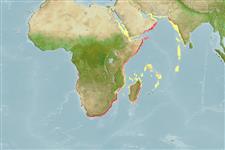Common names from other countries
>
Eupercaria/misc (Various families in series Eupercaria) >
Sparidae (Porgies)
Etymology: Diplodus: Greek, diploos = twice + Greek, odous = teeth (Ref. 45335).
Environment: milieu / climate zone / depth range / distribution range
Ecologia
marinhas associadas(os) a recifes; intervalo de profundidade 0 - 50 m (Ref. 27121). Tropical; - 35°S
Southeast Atlantic and Western Indian Ocean: Angola to Mozambique and southern Madagascar, possibly reaching Mauritius (Ref. 3168, 3198).
Length at first maturity / Tamanho / Peso / Idade
Maturity: Lm 21.1 range ? - ? cm
Max length : 45.0 cm TL macho/indeterminado; (Ref. 3198); common length : 30.0 cm TL macho/indeterminado; (Ref. 3507); Idade máx. registada: 21 anos (Ref. 26244)
Descrição breve
Chaves de identificação | Morfologia | Morfometria
Espinhos dorsais (total) : 12; Raios dorsais moles (total) : 14 - 15; Espinhos anais: 3; Raios anais moles: 13 - 14. Young specimens with fine crossbars; large adults almost uniformly black.
Adults occur in shallow rocky and sandy substrate; juveniles in shallow reefs, estuary mouths and intertidal pools, sandy beach surf zone. Omnivorous on seaweeds, sponges and bivalves. Also feeds on crustaceans, worms, mollusks, and fish. Sold fresh or whole and as bait.
Life cycle and mating behavior
Maturities | Reprodução | Spawnings | Egg(s) | Fecundities | Larvas
Bauchot, M.-L. and J.-C. Hureau, 1990. Sparidae. p. 790-812. In J.C. Quero, J.C. Hureau, C. Karrer, A. Post and L. Saldanha (eds.) Check-list of the fishes of the eastern tropical Atlantic (CLOFETA). JNICT, Lisbon; SEI, Paris; and UNESCO, Paris. Vol. 2. (Ref. 3688)
Categoria na Lista Vermelha da IUCN (Ref. 130435)
CITES (Ref. 128078)
Not Evaluated
Ameaça para o homem
Harmless
Utilização humana
Pescarias: pouco comercial; peixe desportivo: sim; isco: usually
Ferramentas
Relatórios especiais
Descarregue XML
Fontes da internet
Estimates based on models
Preferred temperature (Ref.
115969): 18.6 - 27, mean 25.9 (based on 56 cells).
Phylogenetic diversity index (Ref.
82804): PD
50 = 0.5000 [Uniqueness, from 0.5 = low to 2.0 = high].
Bayesian length-weight: a=0.01514 (0.00951 - 0.02409), b=3.08 (2.95 - 3.21), in cm Total Length, based on LWR estimates for this species & Genus-body shape (Ref.
93245).
Nível Trófico (Ref.
69278): 2.7 ±0.15 se; based on food items.
Resiliência (Ref.
120179): Médio, tempo mínimo de duplicação da população 1,4 - 4,4 anos (tm=3; tmax=21).
Fishing Vulnerability (Ref.
59153): Moderate vulnerability (38 of 100).
